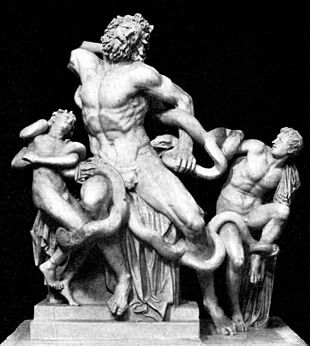Laocoon (Lessing)
In his work Laokoon or Beyond the Boundaries of Mahlerey and Poetry from 1766 Gotthold Ephraim Lessing tries to work out the fundamental artistic differences between fine art and literature.
content
Lessing interprets an example of an ancient work of art, the Laocoon Group , which can be viewed in the Vatican Museums . He describes how the artist found the “fertile moment” in which a whole story, in this case the story of the priest Laocoon and his sons, is summarized in a particularly meaningful way. The viewer can empathize with the tension in the action, the battle is neither won nor lost at this moment. It's an ambivalent situation.
In contradiction to the archaeologist and art theorist Johann Joachim Winckelmann , the literary theorist Lessing argues that fine art and poetry ( in the sense of today's literature ) are not comparable with one another, as was previously the case in the tradition of the Horace quotation " ut pictura poesis " ( “A poem is like a painting”) was demanded (in the Enlightenment by Johann Christoph Gottsched , Johann Jakob Bodmer and Johann Jakob Breitinger, among others ). Lessing emphasizes that poetry arranges words " one after the other " (in time), while painting / sculpture arranges them " next to one another " (in space) through colors and shapes . Therefore "signs arranged next to one another can only express objects that exist next to one another, or whose parts exist next to one another, successive signs but also only express objects that follow one another or their parts one after the other." The visual arts can therefore only represent objects , poetry only actions .
Painting / sculpture can “imitate actions, but only hinted at through bodies.” On the other hand, poetry can also depict bodies, “but only hinted at through actions.” Since painting only depicts a moment of action through the object, painters need to be “the most concise choose from which the preceding and following will be most comprehensible. Likewise, poetry can use only one property of the body in its progressive imitations, and must therefore choose that which arouses the most sensual image of the body from the side from which it needs it. "
He recommends the poet not to give excessive descriptions of an object, person or phenomenon, but to present the description as an action (he cites Homer's variant, which instead of describing the clothes of Agamemnon lets him dress and instead of comparing two sceptres juxtaposing the different stories of both).
Lessing's treatise, which can also be classified in the tradition of the Paragone , achieved an extraordinary influence on the visual arts and art theory .
expenditure
- Gotthold Ephraim Lessing: Laocoon. Or: beyond the boundaries of painting and poetry. With incidental explanations of various points in ancient art history ( Reclams Universal-Bibliothek , 271). Reclam, Stuttgart 1994, ISBN 3-15-000271-0 .
- Gotthold Ephraim Lessing: Laocoon / letters, antiquarian content. Text and comment . Edited by Wilfried Barner , Deutscher Klassiker Verlag, Frankfurt am Main 2007, ISBN 978-3-618-68022-2 .
further reading
- Inka Mülder-Bach: "Image and movement. On the theory of visual illusion in Lessing's Laocoon" , in: Deutsche Vierteljahresschrift für Literaturwissenschaft und Geistesgeschichte 66 (1992), pp. 1–30.
- Inge Baxmann, Michael Franz , Wolfgang Schäffner (eds.): The Laokoon Paradigm. Character regime in the 18th century. Berlin 2000.
- Moniker Schrader: Laocoon - "a perfect rule of art". Aesthetic theories of heuristics in the second half of the 18th century. Winckelmann, Mendelssohn, Lessing, Herder, Schiller, Goethe. Hildesheim u. a. 2005.
- Michael Franz u. a. (Ed.): Electric Laocoon. Characters and media from punch cards to grammatology. Berlin 2007.
- Dorothee Gall, Anja Wolkenhauer (ed.): Laokoon in literature and art. Berlin 2009.
- David Wellbery: Lessing's Laocoon. Semiotics and Aesthetics in the Age of Reason. Cambridge 1984, pp. 116-133.
- Jörg Robert (Ed.): Messy Collectanea. Gotthold Ephraim Lessing's Laocoon between antiquarian erudition and aesthetic theory building. Berlin u. a. 2013.
- Dana König: The Subject of Art: Scream, Lament and Representation. A study on knowledge beyond reason following Lessing and Hegel. Bielefeld 2011.
- Frederick Burwick (Ed.): Lessing's Laokoon: context and reception. Durham, NC 1999.
Web links
- Laocoon in the Gutenberg-DE project
- Laocoon at Zeno.org .
- Laokoon ´Text from vol. 4 of the work edition (Leipzig / Vienna: Bibliographisches Institut, 1911), edited by Georg Witkowski on Google Book Search
Individual evidence
- ↑ (this is how the 'concise moment' was translated into German) (LW 6, 25f.)
